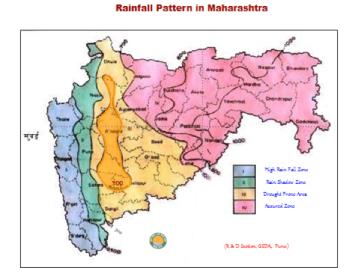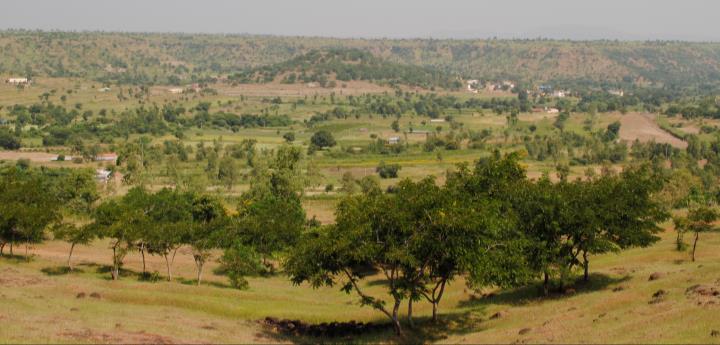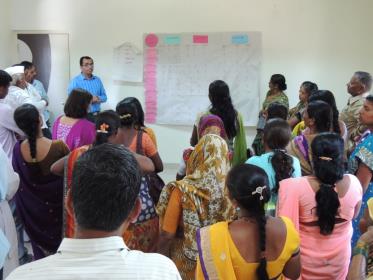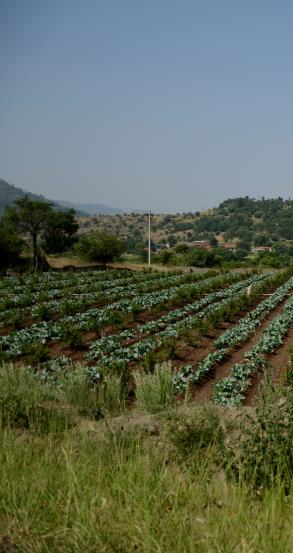Framing the Water Problem
Working with water in the Ahmednagar District, Maharashtra, India
Written by Bhupali Mhaskar, Harish Daware and Neha Gupta
Background
Historically speaking, the Ahmednagar district of Maharashtra, India, is a water scarce zone, receiving on average, an annual rainfall of 450 mm in the 20-30 rainy days of monsoon season. Because of this, rain-dependent agriculture suffers greatly and the availability of water for other domestic uses is greatly restricted. In this context, the Watershed Organisation Trust (WOTR) initiated watershed projects in the district in the early 1990s. WOTR’s efforts resulted in the enhancement of water storage and availability, thus augmenting the entire agricultural sector, especially the productivity of land under cultivation.

However, in the late 2000’s, a decline in water availability was consistently observed in this block, in contrast to the expected increase of water in the area under agriculture. So WOTR channelled much of its efforts into the Climate Change Adaptation (CCA) project in 2010 to understand the various trends and impacts of climate change, and to devise adaptation strategies. This project was in collaboration with the National Bank for Agriculture and Rural Development (NABARD) and the Swiss Agency for Development Cooperation (SDC). Following a severe drought in 2012, the “Drought Forum” was initiated in Ahmednagar in 2013 by WOTR and a group of NGOs, citizens and academic institutes in the district. Its main purpose was to find ways to reduce the impacts of regular drought.

Image: Ahmednagar district of Maharashtra, India
While WOTR grapples with the water problem and initiates some interventions, it is only a concerted effort of the local communities that can make needed lasting adaptive change. It is in this context that WOTR decided to take up the water cause, bringing the subject to the fore for representative groups of stakeholders. WOTR decided that a cluster of 22 villages that fall in the water scarcity zone of the Sangamner block would be the participants of the stakeholder engagement process. These 22 villages are adjacent to one another with a total population of 18,000 divided into approximately 5000 households, and covering an area of almost 20,000 hectares. Of the villages, 17 are part of the CCA project. Along with these, 5 other villages outside this cluster were also included. On account of both low rainfall and water-intensive agricultural practices, water scarcity has persisted in these villages despite good watershed development measures and the fact that these villages are more prosperous than untreated neighboring villages. Consequently, people in these areas are now experiencing competition for subsurface water, high resource exploitation and increasing conflicts within the villages and between neighbouring villages.

Image:
Stakeholder Engagement in the cluster of villages in the Sangamner block of Ahmednagar District
The first stakeholder engagement workshop was organized on the 25th of March 2015 to discuss these water issues and to frame the perspectives of the stakeholders. The meeting was widely representative and gender-inclusive with a variety of stakeholders from different backgrounds in attendance. The stakeholders included village-level government bodies (Gram Panchayat), Women’s Self Help Groups and their federation, Government Child Care Center workers and helpers (Anganwadi workers), grass-root level workers (Wasundhara Sevak and Sewika), Village Development Committees, schools, the local agriculture college, local government departments, Divisional Agricultural Officer Sangamner, three local NGOs, representatives from the Sangamner Sugar Factory and WOTR’s staff. Approximately 65 participants were actively involved. Click here to view a film of the event.
The Stakeholder Engagement Process
Following the general introduction, the objective of defining the water problem was presented to the participants, who agreed that it was a subject that was important to all. The workshop was divided into three sessions.
In the first session the participants were formed into three mixed groups and given different topics to discuss:
Group 1’s topic was to identify stakeholders related to the water issue. Here participants categorized the stakeholders into three levels:
- The primary stakeholders include those who are directly impacted within the village (the smallest unit), e.g., large landowners with water resources, rain-fed agricultural farmers, landless poor, hamlets and the main village, the different caste communities, large and small ruminant owners, etc.
- The secondary stakeholders include the neighbouring villages upstream and downstream, the private water tanker providers, etc.
- The tertiary stakeholders include those who are outside the village but whose plans and actions influence the water use in the village e.g. government plans and policy, service providers, e.g., NGOs and the government officials at the block, district and state levels.
Group 2: This group had to identify the different users of water within a village and how these users have been influenced by watershed development (as watershed development is a large program in India). They looked at what the impacts are in a year of good rainfall and in a year of drought as well as pre-watershed conditions across three seasons - winter (Rabi), Monsoon (Kharif) and summer. They identified 12 user categories and rated the impacts on a scale of 1 to 5 (1 being the worst and 5 being the best). The main uses as decided by the groups are irrigation, rain-fed agriculture, drinking water, domestic use, livestock, large and small ruminants, birds, small businesses, poultry, dairy and construction. What was interesting was that strong debates took place between women and men and also the large farmers and the landless poor, as they had to identify the categories and assign ratings by consensus.
Group 3: This group had to outline trends observed of: (a) changes in climatic conditions viz. temperature and rainfall (from 2000-2015) and the impacts of the variability on human and natural resources; (b) changes in ground water levels from 2000-2015 and number of wells and bore-wells; and (c) changes in irrigated areas and cropping patterns across the same time scale.
As the plenary unfolded, and as each group presented their findings, the participants found linkages between themselves. The findings documented by Group 3 concerning shifting trends – particularly the changes to ground water levels, and the inequitable capture of water by only a few individuals (as a result of a government program that promotes storage tanks and bore wells) – were identified as areas to be addressed.
The second session had the same groups identify the coping mechanisms people and the government fall back on in times of water scarcity and in summer. This is related to water requirements for: (a) domestic purposes with a focus on women and landless poor; (b) agriculture; and (c) livestock. This was followed by plenary presentations and discussions. Although many mechanisms were listed as temporary measures, some good practices were noted, such as villages initiating their own water management systems. Mal-adaptive practices included large storage tanks lifting water from the underground stores and these being used by just a few farmers.

Image: Stakeholder Engagement in the cluster of villages in the Sangamner block of Ahmednagar District
The afternoon plenary session involved a heated and extensive discussion with conflicting viewpoints on the issues and steps needed to contain the aggravating water scarcity. All stakeholders unanimously agreed that water is a natural and national resource to which all creatures and people in all villages have undisputable rights.
In the concluding session, the participants discussed the action plan for the immediate next months:
- Participants would like to share the findings - the charts generated during the workshop – in their respective villages.
-
They stated a need for participatory water budgeting and its application in villages for demand-side water management.
- They would like to take this forward in another workshop before monsoons in the month of May/ June 2015.

Image: Crops in Ahmednagar District
Photo Credits: WOTR & Tali Hoffman